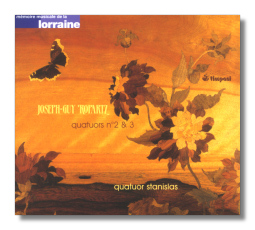
The Internet's Premier Classical Music Source
Related Links
- Latest Reviews
- More Reviews
-
By Composer
-
Collections
DVD & Blu-ray
Books
Concert Reviews
Articles/Interviews
Software
Audio
Search Amazon
Recommended Links
Site News
 CD Review
CD Review
Joseph-Guy Ropartz

String Quartets, Volume 1
- String Quartet #3 in E Major (1925) [27:03]
- String Quartet #2 in D minor (1911-1912) [31:14]
Stanislas Quartet
Recorded July 2004, Released May 2006
Timpani 1C1099 58:28
The Breton born Joseph-Guy Ropartz (1864-1955) was an excellent French composer and conductor whose music virtually disappeared well before his death. One explanation was his close musical allegiance to César Franck resulting in the common view that Ropartz was a Franckian throwback. The other reason was that Ropartz's competition just happened to be Maurice Ravel and Claude Debussy.
I won't try to argue that Ropartz's music stands tall next to Ravel or Debussy; it does not. However, judging from a few Ropartz discs including the one now being reviewed, his music has much to offer with very attractive melodies and highly evocative sea and landscapes cloaked in a late-romantic language of impressionist leanings, contrapuntal vigor, sweet tonal passages and mild doses of dissonance. Some serious angst does emerge from time to time, but Ropartz is generally optimistic in musical character.
In terms of production, Ropartz was a busy boy as composer, academic administrator and conductor. His musical output includes five symphonies, 6 string quartets, 3 violin sonatas, two cello sonatas, piano trio, string trio, solo piano and ogan works, ballets, numerous choral works, several operas and over 100 songs. From 1894 to 1919, Ropartz was the Director of the Nancy Conservatoire and then spent the next ten years as the conductor of the Strasbourg Orchestra.
The Timpani disc being reviewed is Volume 1 of a three volume cycle of the Ropartz String Quartets. The second volume, released just a few weeks ago, contains Quartets 4, 5 and 6. As it happens, the Stanislas Quartet recorded Quartet #4 for Timpani back in 1996; the disc was released with the Ropartz Piano Trio in A minor, and it will be interesting to see if the group has altered its view of the work in the past few years.
Let's get to the matter of the Quartets #2 and 3. The D minor Quartet is based on a four-note cell that is shared by each instrument and subjected to modifications. In the 1st Movement, the cell never seems to have any particular destination, preferring to participate in a mix of raw expression and repose. There's no question of destination in the 2nd Movement Scherzo as the four-note cell now takes on the role of a bass ostinato that has determination and drive written all over it; this fast and severe music is excellently contrasted by the sweet middle section.
Although quite enjoyable, the first two movements of the D minor Quartet must yield to the gorgeous 3rd Movement Adagio with its sinuous lines particularly memorable. Also, unlike in the first two movements, musical phrases now combine the sweet with the bitter, giving the music a greater breadth and richness of expression. The 4th Movement finds our four-note cell put to optimistic use, while the mysterious middle section is stunning in its beauty.
Before addressing the G Major Quartet, I have to tell you how impressed I am at the conclusions of each of the eight movements on the disc. They are concise, meaningful, and every note has purpose. When I think of Ropartz, I think of outstanding conclusions.
Written thirteen years after the D minor Quartet, the G Major finds Ropartz leaving Franckian territory and instead concentrating on more adventurous harmonies. However, the basic Ropartz foundation of sweetness vs. dissonance continues from the earlier D minor Quartet. Particularly compelling are the 2nd Movement Scherzo "Assez vif" and the 3rd Movement marked "Tres lent". The Scherzo has tremendous energy and drive with dotted rhythms adding to the effect, while the composer gives us a gorgeous trio section having an hypnotic ostinato. The slow 3rd Movement is perhaps the most beautiful music Ropartz ever penned; although he doesn't make time stand still, he does insure it oscillates in seductive patterns.
Such fine music deserves the best in terms of engineering and performance. The acoustics are superb in detail, depth and clarity. The performances are also top-rate except for one consideration - the Stanislas Quartet could have been more forceful and desperate in Ropartz's strongest passages such as the Scherzo of the G Major Quartet; this is music with a huge "wow" factor, but the Stanislas only scratch its surface.
Don's Conclusions: Strongly recommended for those who run the unbeaten path or love early 20th-Century chamber music. Although I have noted a disappointment with one aspect of the performances, it should also be stated that the Stanislas Quartet delivers the full lyricism and beauty of the scores. My hat's off to Timpani for giving us this repertoire, and I'll soon be off again to the Ropartz soundworld with Volume 2.
Copyright © 2007, Don Satz




















